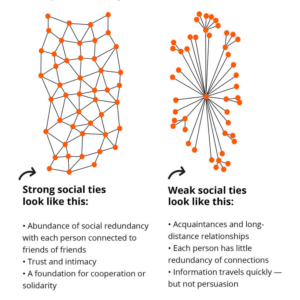
How to trigger behavioral change is a question many advocates have asked and tried to answer, often unsuccessfully. The answer could be as simple as starting small, concentrating on trusted connections and repeating a simple message over and over.
Believe it or not, there is something called network science that researches what makes ideas contagious. Damon Centola, an associate professor in the Annenberg School for Communication and the School of Engineering and Applied Sciences at the University of Pennsylvania, has written How Behavior Spreads challenging the notion that exposure is the key to behavioral change.

Centola describes “simple contagions” and “complex contagions”. Simple contagions are like memes, tunes or catch-phrases that can spread widely fast based on “weak social ties”, often via social media. Complex contagions to effect behavioral change or alter long-held viewpoints take longer to sprout and are adopted gradually based on “strong social ties” such as trusted friendships or existing connections.
“For simple contagion to spread, all it takes is contact with one person,” Centola explained in an interview on Hidden Brain. “For a complex contagion, you need to be convinced.”
Centola offers useful insight for public affairs and social marketing professionals pursuing behavioral change. Leaders should start small and go for redundancy. They should make the case for transformation through their strong ties and let it reverberate among those connections until they convince themselves that it is both real and necessary. And then, leaders can let their strong ties spread the word through their own strong ties.
“Viewed from the relational perspective of each individual, strong ties are the most important links in the social network,” Centola writes. “They are proximate, trusted and familiar, and therefore the most influential for diffusion.”
“There is,” writes Centola, “an important distinction between being exposed to a behavior – and knowing it is an option for you – and actually deciding to adopt that behavior for yourself.” The complexity of the transformational behavior is what requires strong social ties forged by trust.
Centola offers another valuable, time-saving insight for behavioral change agents. The top dog at a large business may not be the most likely agent of change in the organization because they are more likely to be risk-averse. Instead, Centola suggests testing innovative ideas at the periphery of an organization where workers have a different risk/reward calculation.
The practical application of Centola’s insights can be distilled as differentiating strategies and tactics for disseminating information from behavioral change advocacy. A Twitter account may suffice for information dissemination, while behavioral change advocacy will require more arduous approaches centering on trusted messengers as word-of-mouth campaigns or targeted grassroots outreach.
Centola’s observations also suggest looking for credible disciples at the edges, not necessarily established leaders, celebrities or influencers. Credible disciples can spread the word through their own circles of trust to build momentum until a critical mass forms and gains wider notice.
These strategies and tactics are not foreign to experienced public affairs or social marketing professionals, though they may not satisfy impatient clients who want change now. Selling eager clients on a slower, surer path to behavioral change will require persuasion and proof of concept. There are examples that support Centola’s assertions.
There is an important distinction between being exposed to a behavior – and knowing it is an option for you – and actually deciding to adopt that behavior for yourself. The complexity of the transformational behavior is what requires strong social ties forged by trust.
Here are two of my favorites that verify the start small, rely on strong connections and repeat-repeat-repeat strategy urged by Centola:
Chip and Dan Heath, in their book Switch: How to Change Things When Change is Hard, tell the story of Jerry Sternin of Save the Children who was sent to Vietnam in 1990 to address child malnutrition in rural villages. Vietnamese officials gave Sternin six months to make a dent. Instead of seeking and advocating some massive change, Sternin looked for what the Heath brothers labeled as “bright spots” or what psychologists call “positive deviance”, which in this case meant ideas that were achievable and could be adopted rapidly with virtually no outside help.
Sternin visited villages and discovered children thrived who were fed three or four times daily. The mothers who fed their children more frequently also scavenged tiny shrimps, crabs and potato greens from nearby rice paddies to supplement their children’s meals. Armed with a solution, Sternin recruited these mothers to act like missionaries by going to village after village to share their secret sauce to ward off child malnutrition. The nutritional success of these mothers was persuasive and there were no significant barriers to adoption of their techniques. Eventually, the program Sternin launched improved the lives of 2 million Vietnamese children. His example shows the power of looking at the periphery for a success story, which then can be used to galvanize wider acceptance of a behavioral change, producing sustainable benefits.
The Harvard School of Public Health in 1988 undertook a campaign to promote designated drivers, a concept that originated in Scandinavia, but which required altering embedded social norms about driving after drinking in America. The initiative approached Hollywood studio officials to encourage them to write in designated drivers in episodes of popular programs such as Cheers. The voices viewers heard were familiar and the settings were relatable. Over a four-year period, designated drivers were incorporated into more than 160 prime-time program scripts, earning the equivalent of more than $100 million worth of network airtime.
In reflecting on the successful initiative, the School noted, “We took a highly complex problem, broke it down into separate, manageable components, and selected one component where there seemed to be a meaningful opportunity to achieve change at the time. The campaign’s message called for only a modest shift in behavior. Instead of a negative message – “Don’t drink and drive”, the campaign promoted a positive, empowering message – “The Designated Driver is the Life of the Party”.
Advocating for behavioral change is one of the hardest public affairs or social marketing challenges. Centola’s insights direct advocates to look for less obvious starting places and for different, unsuspecting leaders to launch contagious, transformational change. He also would endorse pursuing change in chunks that can over time accumulate into mountains of success.




